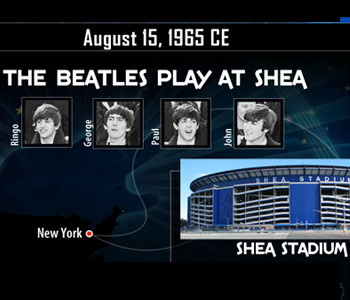Click to view full Infographic After bringing Beatlemania across The Pond in 1964, George, Paul, John and Ringo decided to take things to a whole new level on their second American tour the following summer. Packing 55,000 people into Shea Stadium in the New York City borough of Queens, the Beatles set records for attendance and profits from a concert on August 15, 1965 – and the ability to pull off large-scale outdoor events suddenly became feasible for promoters and bands all over the world. For many, the two-week tour that kicked off in New York City represented the height of the Beatles’ popularity in America. Arriving at the Port Authority Heliport in Flushing Meadows Corona Park by helicopter, a handful of the 2,000-strong security team quickly huddled the band into a Wells Fargo armored truck for the 14-block drive to a rocking Shea Stadium. Four opening acts – King Curtis, Cannibal and the Headhunters, Brenda Holloway and Sounds Incorporated – had taken the stage, but the arrival of the main act brought a deafening roar from the stands. The Beatles took the stage on a large platform near the center of the field, joined on the playing surface only by security guards and members of the management team. Despite their best efforts, only a handful of spectators were able to make it down to the same level – and those few were quickly wrangled and transported out. The vast distance between the fans (and their eardrum-bursting screams) made it difficult for any sound to reach them. Though speaker company Vox had manufactured powerful new amplifiers specifically for the tour, the 30-minute set had to be broadcast over the stadium’s speaker system for anyone to hear it. The band themselves, unable to discern if they were working in unison or not, played through the standard selection from the European tour and hoped it sounded good to the paying crowd. Afterwards, the show’s promoter, Sid Bernstein, reported record revenue: “We took $304,000, the greatest gross ever in the history of show business.” The record-smashing attendance demonstrated musical performances could clearly be taken into massive stadiums and filled-to-the-brim arenas so long as the equipment was able to handle producing sound. Any artist capable of drawing such a huge audience now understood the possibilities a dedicated – even frenzied – fan base could generate. The Beatles would go on to play ten more shows in the United States and Canada, moving out west to Los Angeles for two performances at the famous Hollywood Bowl. The next day, August 31st, the band played in Daly City near San Francisco before returning to England for a six-week break. After rocking the American music scene once again, the four men from Liverpool had earned a rest before their next trip to the studio. Four decades later, a recording of the entire concert popped up. The clear, unedited sound from the Shea Stadium amplification system gave fans the opportunity to hear the iconic group together for its signature show once again for the first time – some of whom had even been part of the multitude that night.
August 15, 1965 CE – The Beatles Play at Shea

